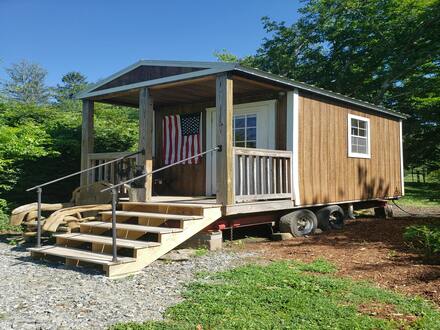Welcome, homeowners! Are you interested in maximizing your property’s potential and increasing its value? If so, look no further because today we are diving into the world of Accessory Dwelling Units (ADUs) right here in Maryland and Washington DC. As a homeowner, it is important to stay informed about all possibilities and options when it comes to your property. ADUs have become an increasingly popular option for homeowners looking to make use of their existing space or create additional living spaces on their property. In this blog post, we will discuss everything you need to know about ADUs in Maryland and Washington DC – from what they are and why they’re beneficial, to regulations and laws surrounding them. So grab a cup of coffee or tea, get cozy, and let’s dive into the exciting world of ADUs!

Introduction to ADU’s (Accessory Dwelling Units) and their benefits
If you’re looking for a flexible and practical way to add extra living space to your home, look no further than an Accessory Dwelling Unit (ADU). ADUs are a type of secondary dwelling unit that can be built onto an existing property, providing a self-contained living space that’s separate from the main house. They come in a variety of styles and sizes and can be customized to suit your needs, whether you need a granny flat for an aging relative, a home office, or a rental property to generate extra income. Best of all, ADUs offer a range of benefits, from increased property value and rental income to enhanced privacy and lifestyle customization. Learn more about this exciting housing trend and discover how an ADU could transform your home and life.
Overview of regulations and zoning laws for ADU’s in Maryland and Washington DC
As the demand for more affordable and sustainable housing options increases, the popularity of Accessory Dwelling Units (ADUs) continues to rise. However, before considering adding an ADU to a property in Maryland and Washington DC, it is important to understand the regulations and zoning laws that govern such structures. The county has established specific guidelines for ADUs in terms of size, placement, parking, and occupancy. It is also important to take into account any neighborhood covenants or homeowners association rules that may apply. By familiarizing oneself with the regulations and laws, homeowners can ensure they are in compliance and avoid any potential legal issues.
Step-by-step process for obtaining permits and approvals for building an ADU
Building an accessory dwelling unit (ADU) can be a great way to add extra space to your property for family members, guests, or even renters. However, before you start construction, it’s important to obtain the necessary permits and approvals. The process can seem daunting at first, but a step-by-step approach can make it more manageable. First, you’ll need to research your local zoning laws and regulations to determine if you’re even eligible to build an ADU on your property. Then, you’ll need to submit detailed plans and obtain approvals from various city departments, such as planning, building and safety, and utilities. Finally, you’ll need to get a building permit and have inspections throughout the construction process to ensure your ADU meets all necessary building codes. While the process may take some time and effort, the end result will be a legal, safe, and comfortable space for your loved ones or tenants.
The different types of ADU’s – detached, attached, garage conversion, etc.
Accessory Dwelling Units, or ADUs, have become increasingly popular over the years as more and more homeowners look to increase their property value or generate additional income. But did you know that there are different types of ADUs available? For instance, you could opt for a detached ADU, which is entirely separate from the main house. Alternatively, there’s the attached ADU, which is connected to the main house and shares some of the same walls. Then there’s the garage conversion ADU, which repurposes a garage, into a fully-functional home. Each type of ADU offers unique benefits and challenges, making it important to carefully consider which one could be the best fit for your property.
Tips for designing and maximizing space in your ADU
If you’re planning on building an accessory dwelling unit (ADU), then you might be wondering how you can make the most of the space you have. After all, ADUs are often small, so you want to ensure that every inch is utilized efficiently. One tip is to think vertically – install shelving and storage all the way up to the ceiling to maximize space. Additionally, consider multi-functional furniture, such as a sofa bed or a fold-out table, to save on floor space. Another idea is to use light colors and keep the area clutter-free to create a sense of openness. With these tips, you’ll be able to design a functional yet cozy ADU.
Cost-effective materials and designs for building an ADU on a budget
Building an Accessory Dwelling Unit (ADU) can be a great way to maximize your property’s value while generating additional income. However, it can be difficult to achieve it on a budget. A cost-effective approach to designing and building an ADU would be to select affordable building materials that don’t compromise on quality. Choosing designs that use space efficiently and reduce the need for additional construction can also lower the cost of building an ADU. Additionally, opting for pre-fabricated ADUs can help minimize construction costs while still providing a stylish and functional living space. With careful planning and execution, constructing an ADU that is both cost-effective and functional is well within reach.
Potential rental income from an ADU and its impact on property value
If you’re considering building an accessory dwelling unit (ADU) on your property, one aspect that’s worth taking note of is the potential rental income that it can generate. Depending on your location, this can be a significant amount. The amount of rental income can vary depending on factors like the size of the ADU and its amenities. Renting out an ADU can also increase the overall value of your property, as it offers an additional source of income. Moreover, if you ever decide to sell your property, having an ADU can make it a more attractive investment to buyers who are looking for rental income or who plan to use the ADU as a home office, guest house, or long-term accommodation for family members. Considering all these factors, it’s not surprising why many homeowners are taking the leap and building ADUs for rental income purposes.
Real-life examples of successful ADU projects in Maryland and Washington DC
Maryland and Washington DC has seen a surge of successful accessory dwelling unit (ADU) projects being implemented over recent years. The popularity of ADUs as a form of affordable housing, for both homeowners and renters, has been met with support and encouragement from local authorities. Real-life examples can be seen in areas such as Long Reach and Elkridge. One Long Reach resident constructed a two-story ADU in his backyard and has since been able to rent it out to a family, providing them with a comfortable and affordable home. Similarly, an Elkridge homeowner built a detached ADU, which she now uses as a source of rental income. These are just a few of the many ADU projects that have been successful within Maryland and Washington DC. As local authorities continue to work towards expanding ADU regulations, the implementation of these projects is expected to rise even higher in the upcoming years.
Addressing common concerns and misconceptions about ADU’s
Accessory Dwelling Units or ADUs are gaining popularity as a means of affordable housing solutions in many urban areas, but common concerns and misconceptions still surround these structures. One common worry is that ADUs might decrease property values, when in fact, studies have shown that they often boost them. Another misconception is that these units are only suitable for renting out to family and friends, but ADUs can serve as a long-term living space for homeowners as well. Many also worry about the legality of building an ADU, but with the right permits and compliance with building codes, homeowners can safely construct one. By addressing these misconceptions, homeowners can understand the benefits and potential of ADUs for their living situation.
Conclusion on the potential benefits of adding an ADU to your property in Maryland and Washington DC
If you’re a homeowner in Maryland and Washington DC, you may have considered adding an accessory dwelling unit (ADU) to your property. And the truth is, there are potential benefits to doing so. An ADU can provide additional living space for family members or renters, potentially generating extra income. It can also add value to your property and give you the flexibility to age in place or provide housing options for loved ones. However, it’s important to do your research and ensure that an ADU fits within zoning regulations and won’t have negative impacts on your neighbors. Overall, an ADU can be a smart investment for many Maryland and Washington DC homeowners.




